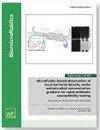Effect of the shear rate and residence time on the lysis of AC16 human cardiomyocyte cells via surface acoustic waves
IF 2.6
4区 工程技术
Q2 BIOCHEMICAL RESEARCH METHODS
引用次数: 0
Abstract
The efficient breakage of one cell or a concentration of cells for releasing intracellular material such as DNA, without damaging it, is the first step for several diagnostics or treatment processes. As the cell membrane is easy to bend but resistant to stretching, the exposure of the cell to a shear rate during a short period of time can be sufficient to damage the membrane and facilitate the extraction of DNA. However, how to induce high shear stresses on cells in small microliter volumes samples has remained an elusive problem. Surface acoustic waves operating at high frequencies can induce acoustic streaming leading to shear rates sufficient to cell lysis. Lysis induced by acoustic streaming in sessile droplets has been investigated in the past from the lysis efficiency point of view. However, the effects of the velocity field and shear rate induced by acoustic streaming on the lysis process remain unexplored. Here, we study the lysis of AC16 human cardiomyocytes in microliter droplets under the effect of the shear rate induced by acoustic streaming. It is identified that for a given shear rate, the extracted DNA is also affected by the actuation period which can be attributed to a cycling process that leads to an accumulation of damage on the cell membrane.剪切率和停留时间对通过表面声波裂解 AC16 人类心肌细胞的影响
在不损伤细胞的情况下,有效地破碎一个或多个细胞以释放细胞内物质(如 DNA),是多种诊断或治疗过程的第一步。由于细胞膜容易弯曲但不易拉伸,因此在短时间内将细胞暴露在剪切率下就足以破坏细胞膜并促进 DNA 的提取。然而,如何在小微升体积样品中诱导细胞产生高剪切应力仍是一个难以解决的问题。高频率的表面声波可诱导声流,从而产生足以导致细胞裂解的剪切率。过去曾从裂解效率的角度对无柄液滴中声波流诱导的裂解进行过研究。然而,声流诱导的速度场和剪切率对裂解过程的影响仍未得到研究。在此,我们研究了在声流诱导的剪切率作用下,微升液滴中 AC16 人类心肌细胞的裂解过程。研究发现,在给定的剪切率下,提取的 DNA 也会受到致动周期的影响,这可归因于导致细胞膜损伤累积的循环过程。
本文章由计算机程序翻译,如有差异,请以英文原文为准。
求助全文
约1分钟内获得全文
求助全文
来源期刊

Biomicrofluidics
生物-纳米科技
CiteScore
5.80
自引率
3.10%
发文量
68
审稿时长
1.3 months
期刊介绍:
Biomicrofluidics (BMF) is an online-only journal published by AIP Publishing to rapidly disseminate research in fundamental physicochemical mechanisms associated with microfluidic and nanofluidic phenomena. BMF also publishes research in unique microfluidic and nanofluidic techniques for diagnostic, medical, biological, pharmaceutical, environmental, and chemical applications.
BMF offers quick publication, multimedia capability, and worldwide circulation among academic, national, and industrial laboratories. With a primary focus on high-quality original research articles, BMF also organizes special sections that help explain and define specific challenges unique to the interdisciplinary field of biomicrofluidics.
Microfluidic and nanofluidic actuation (electrokinetics, acoustofluidics, optofluidics, capillary)
Liquid Biopsy (microRNA profiling, circulating tumor cell isolation, exosome isolation, circulating tumor DNA quantification)
Cell sorting, manipulation, and transfection (di/electrophoresis, magnetic beads, optical traps, electroporation)
Molecular Separation and Concentration (isotachophoresis, concentration polarization, di/electrophoresis, magnetic beads, nanoparticles)
Cell culture and analysis(single cell assays, stimuli response, stem cell transfection)
Genomic and proteomic analysis (rapid gene sequencing, DNA/protein/carbohydrate arrays)
Biosensors (immuno-assay, nucleic acid fluorescent assay, colorimetric assay, enzyme amplification, plasmonic and Raman nano-reporter, molecular beacon, FRET, aptamer, nanopore, optical fibers)
Biophysical transport and characterization (DNA, single protein, ion channel and membrane dynamics, cell motility and communication mechanisms, electrophysiology, patch clamping). Etc...
 求助内容:
求助内容: 应助结果提醒方式:
应助结果提醒方式:


